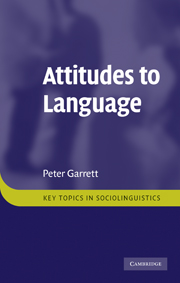Book contents
- Frontmatter
- Contents
- List of figures
- List of tables
- Acknowledgements
- 1 Introduction
- 2 Fundamentals of language attitudes
- 3 Main approaches to the study of language attitudes
- 4 Matched and verbal guise studies: focus on English
- 5 Matched and verbal guise research in more contexts
- 6 Attitudes to speech styles and other variables: communication features, speakers, hearers and contexts
- 7 Communication accommodation theory
- 8 Language attitudes in professional contexts
- 9 Societal treatment studies
- 10 Direct approach
- 11 Folklinguistics
- 12 An integrated programme of language attitudes research
- 13 Conclusion
- Glossary
- References
- Index
- References
7 - Communication accommodation theory
Published online by Cambridge University Press: 05 June 2012
- Frontmatter
- Contents
- List of figures
- List of tables
- Acknowledgements
- 1 Introduction
- 2 Fundamentals of language attitudes
- 3 Main approaches to the study of language attitudes
- 4 Matched and verbal guise studies: focus on English
- 5 Matched and verbal guise research in more contexts
- 6 Attitudes to speech styles and other variables: communication features, speakers, hearers and contexts
- 7 Communication accommodation theory
- 8 Language attitudes in professional contexts
- 9 Societal treatment studies
- 10 Direct approach
- 11 Folklinguistics
- 12 An integrated programme of language attitudes research
- 13 Conclusion
- Glossary
- References
- Index
- References
Summary
So far in this book, language use has taken a relatively immobile form, although there have been some glimpses of mobility in the treatment of a few areas such as speech rates, codeswitching and degrees of accentedness. Accommodation theory foregrounds the dynamic communicative shifts that can occur as we respond in communicative interaction. The study of language attitudes needs to take account of these, since the psycho-social processes that attitudes research deals with are also those that inform choices that we make in interaction. Making adaptations as we communicate with others may be (or may be seen as) a behavioural signal of our own attitudes, and these adaptations may themselves also evoke attitudinal responses in our communication partners, as well as bystanders, eavesdroppers, members of wider audiences etc. Hence communication accommodation theory can also be seen as the implementation of attitudes in discourse.
As a sociolinguistic theory, it is also a counter to the more deterministic view of style that Labov employed in his seminal sociolinguistic research, in which styles covering different levels of formality were elicited from speakers by giving them different tasks (reading lists of words, talking about their own experiences etc.). Giles points to the absence of information of the interviewer's accent or speech style during Labov's sociolinguistic interviews (e.g. Giles and Powesland 1975: 171), and raises the question of whether the style features of the interviewees' speech in his research might have been influenced by the interviewer's speech features rather than by the task alone.
- Type
- Chapter
- Information
- Attitudes to Language , pp. 105 - 120Publisher: Cambridge University PressPrint publication year: 2010

